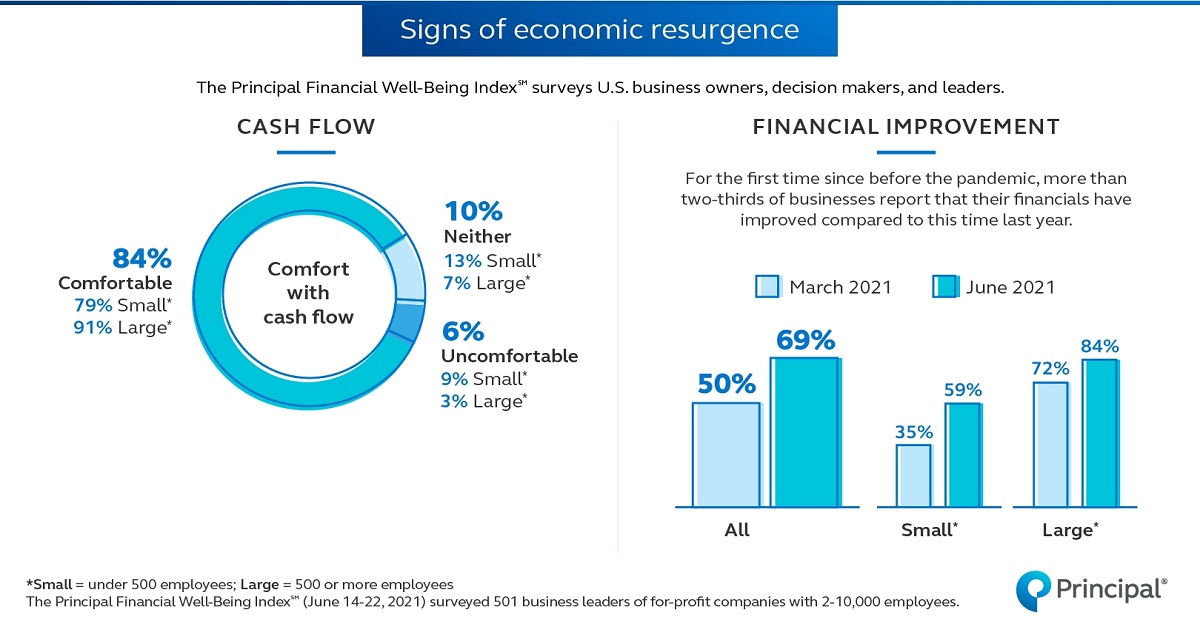Small and Medium-Sized Businesses Plan to Increase Employee Benefits to Spur Hiring, Growth
Principal Financial Group | August 25, 2021

Principal Financial Group® reported today an increased focus on key employee well-being initiatives and how benefits are helping employers cope with the pandemic fluctuation as they also make businesses more competitive for the next phase of recovery and growth. Over 90% of surveyed businesses plan to increase at least one benefit in the next 12 months.
While recent variants of COVID-19 could bring extra hurdles to the recovery efforts small and medium-sized businesses (SMBs) are putting in place, the latest Principal Financial Well-Being Index℠ results show most businesses (82%) expect their financials to keep improving over the next 12 months and are ready to move forward when given the chance.
The pulse survey of 500 employers from companies with two to 10,000 employees spans a diverse array of industries, with more than half of the employers falling within finance/insurance, professional/scientific/technical, construction, manufacturing, and information management. Data shows that almost 70% of surveyed businesses have improved financials, compared to this time last year2, and 84% are comfortable with their cash flow despite the continuing impact of the pandemic.
Greater competition for talent means more benefits and digital access
With the resiliency that small and medium-sized businesses have shown during the last 18 months and a national increase in hiring3, greater competition for talent is underway. Sixty-three percent of businesses reported being fully operational, driving the need for additions to their workforce, and more businesses say they’re hiring, from fewer than one-third in March to nearly half in June.
“As businesses start to ramp up operations, employers are dealing with the complex American labor shortage and a workforce empowered to determine where they want to work and what they want from an employer, making benefit offerings more critical,” says Amy Friedrich, president of U.S. Insurance Solutions at Principal®.
The significant role employee benefits play in this recovery seems more apparent than ever. Employers are choosing certain benefits to address specific employee needs. A list of 18 benefits tracked by the survey—everything from retirement savings to pet insurance—made gains. A greater percentage of businesses plan to increase telehealth (42%), healthcare benefits (41%), and mental health/well-being services (38%) in the next 12 months.
The focused efforts to increase benefits are accompanied by changes to the way businesses are presenting them to their workforce. Sixty-five percent of businesses are improving digital access to benefits for employees, while only 14% lack any digital options. According to those surveyed, this digitalization addresses the need to help employees better understand their benefits (71%), onboarding employees online (62%), and the need of reducing paper (40%).
Friedrich explains that the unprecedented events of the last 18 months forced businesses to adapt in order to survive, and now they must become more competitive recruiters to grow again. “Today, winning the differentiation battle has gone from experimenting with e-commerce to supporting a remote workforce and offering a full suite of resources at their fingertips, including benefits.”
Financial wellness and retirement plans trending with employers
There is broad agreement among employers that investing in financial wellness programs is also key to recovery. About 70% of employers agree with the positives of financial wellness programs, ranging from improving employee long-term financial planning to helping attract and retain talent. But only 62% of businesses currently offer financial wellness benefit programs.
“We have seen increased interest in financial wellness programs and guidance from clients over the past year, with a growing understanding that these offerings are essential not just for employees, but also for business success,” said Renee Schaaf, president of Retirement & Income Solutions at Principal. “Offering impactful financial wellness solutions can be daunting, which is why it’s so important that businesses of all sizes and industries have access to simple, customizable solutions.”
Forty-five percent of businesses see access to a financial professional as the most useful financial wellness offering for employees (out of 25 options in the survey). That is followed by tax preparation services (35%), identity theft protection (34%), and savings programs for higher education (34%).
Employers also acknowledged the importance of retirement plans to their workforce. Over 80%4 of businesses see retirement plan offerings as essential in the attraction and retention of talent, and 74% of employers feel it is their role to help employees prepare for retirement.
This desire for retirement plan offerings comes at a time when lawmakers are advocating for increased incentives and programs to help small and medium-sized businesses with retirement offerings. Many of these businesses, however, are not aware of these programs or their positive impact.
Of employers with less than 500 employees, a little under half5 are aware of proposed legislation known as The Securing a Strong Retirement Act (SECURE 2.0) in Congress that could help them implement or expand retirement offerings. In contrast, 90% of businesses with 500 to 10,000 employees know about the proposed legislation.
“We have a window of opportunity for businesses to get support in implementing retirement plans to aid their employees overall financial security,” Schaaf said. “We are working to provide the best possible retirement solutions to small and medium-sized businesses as well as educate them on the options available to them now and in the future.”
About the Principal Financial Well-Being Index℠
The Principal Financial Well-Being Index℠ surveys business owners, decision makers and business leaders aged 21 and over who work at companies with 2 – 10,000 employees. The nation-wide survey, commissioned since 2012, examines the financial well-being of American workers and business employers. In response to COVID-19, the Well-Being Index was transformed from an annual survey to a quarterly pulse, offering three waves, revisiting questions and measuring sentiment regarding timely issues in the small and medium-sized business marketplace.